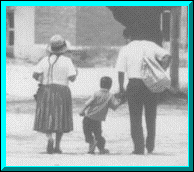Poliomyelitis:
On 9 April 1999, the World Health Organization announced that it had confirmed that
an outbreak of paralysis among children in Luanda, Angola, had been linked to type
III poliovirus. All of the children are unvaccinated or partially vaccinated.
According to unconfirmed reports, 206 children are affected.1
Although the last known case of polio in the Western hemisphere was
reported in 1991 and there has not been a case in Western Asia since 1997, polio is still
rampant in South Asia, West Africa, and Central Africa. Approximately 5,000 cases
are diagnosed each year. Although that represents a 90% decrease in just the last
ten years, that is still too many children killed or permanently disabled in regions of
the world which are still driven by human physical labour.2

Luis Tenorio, the last person with
wild polio in the Western hemisphere.
In 1988, WHO launched it's Global Polio Eradication Initiative with the
goal of eliminating this dread disease by the year 2000. In partnership with
programmes like Rotary International's PolioPlus, the CDC, United
Nations Children's Fund (UNICEF), and the governments of non-endemic nations, they are
quarantining active epidemics and vaccinating millions of people in at-risk areas.3
The drive to eliminate poliovirus by 2000 may be stymied by outbreaks of
political violence in Africa and Southwest Asia. But polio's days on this planet are
numbered.4,5
Post-Polio Syndrome: Many of
the people who survived their bouts with paralytic poliomyelitis in the 1940s and 1950s
are suffering from a new condition that ranges from pain to weakening of the muscles to
various degrees of paralysis. Research into this new syndrome is ongoing, but it is
apparently related to a normal weakening of muscles that occurs as people age when applied
to muscles that were already weakened by polio.6 If this
is the case, options for treatment may be limited.
Support groups have grown up around the world for people who now suffer
from Post-Polio Syndrome.
The March of Dimes: In 1958,
with both the Salk and Sabin vaccines working to reduce the incidence of poliomyelitis,
the National Foundation for Infantile Paralysis declared their campaign over. The
Foundation was reorganized as the March of Dimes Birth Defects Foundation, with the goal
of eliminating birth defects and reducing infant mortality world wide. It continues
to fund research, now into the causes and treatment for various birth defects, and
publishes educational materials for medical professionals and expectant mothers.
March of Dimes researchers were the first to describe Fetal Alcohol Syndrome, and their
current campaign to promote increased consumption of folic acid during pregnancy has
already resulted in a reduction in the number of babies born with neural tube defects.
One of the March of Dimes most public fundraising efforts is its annual
WalkAmerica, a pledged walk-a-thon. In 1998, more than one million people
participated at over 1400 sites around the nation, raising 75.5 million dollars for
research and education.7 The name "Mothers
March" also lives on. It is now a letter-writing campaign that distributes
educational materials and raises $24 million a year for March of Dimes programs.8
Ten researchers, including Linus Pauling (molecular bonding) and James
Watson (helical structure of DNA), have won Nobel Prizes for work done on March of Dimes
research grants.9
The March of Dimes continues to provide financial assistance for
approximately 100 polio survivors who require iron lungs or respiratory therapy.10
The March of Dimes is the only medical foundation that has fulfilled its
original charter: the discovery of a vaccine for poliomyelitis.
OPV vs. IPV Controversy: In
much of the world, poliomyelitis from wild poliovirus has been eliminated, but each year,
a very few cases of poliomyelitis are contracted by either infants who have just been
immunized or non-immune older children or adults with whom those infants come into
contact. This is called VAPP, or vaccine associated paralytic polio. (These
people may be non-immune because they were never vaccinated or because they failed to
develop immunity when vaccinated.) VAPP is caused by the use of the OPV or oral
polio vaccine, which contains live, weakened poliovirus.11
This is based upon the vaccine developed by Albert Sabin.
The alternative to OPV is IPV, inactivated polio vaccine. This
vaccine contains killed poliovirus, and is based upon the vaccine developed by Jonas Salk.
Some people believe that all polio vaccinations should be IPV.
Others argue that OPV is necessary, because newly vaccinated children "shed" the
virus, which can immunize or boost the immunity in people the child contacts.
Recently, the CDC has changed its protocol to recommend that children be vaccinated with
two doses of IPV and two additional doses of OPV.12
Eventually, following some reasonable period after poliomyelitis is
eliminated, there will be no further need to vaccinate. Polio will go the way of
smallpox.


Footnotes
1. Avram, Valery. "Polio Outbreak in Central
Africa." The Beginning of the End. 1999. http://whqsabin.who.int:8082/newsrelease21e.htm.
(8 May 1999).
2. ibid.
3. ibid.
4. "Impact of strategies on poliomyelitis
incidence." International Society of Travel Medicine. 1998.
http://www.istm.org/news_share/199803/poliomy.html.
(8 May 1999).
5. "War Halts Congo's Plan Against
Epidemics." World Health Organization. 25 October 1998. http://www.who.int/gpv-news/news/251098.war_halts_congo.htm.
(8 May 1999).
6. Matheson, Mavis J., M.D. "Post-polio Syndrome
(PPS): Information for Physicians." The Rollin' Rat: Post-Polio Syndrome
& Disability Resources. April 1995. http://www.azstarnet.com/~rspear/mavis.html.
(27 May 1999).
7. "WalkAmerica." March of Dimes.
1999. http://www.modimes.org/ShowYourSupport2/WalkAmerica/Default.htm.
(5 June 1999).
8. "Mother's March." March of Dimes.
1999. http://www.modimes.org/ShowYourSupport2/MothersMarch/Default.htm.
(5 June 1999).
9. "Milestones—A Track Record of
Success." March of Dimes. 1999. http://www.modimes.org/About2/Milestones/Default.htm.
(3 June 1999).
10. "Polio." March of Dimes.
1999. http://www.modimes.org/HealthLibrary2/factsheets/Polio.htm.
(3 June 1999).
11. "Polio Vaccination: What Parents Should
Know." Informed Parents Against VAPP. http://www.ipav.org/factsheet.html.
(27 May 1999).
12. "Polio Vaccines: What You Need to Know." U.S.
Department of Health and Human Services, Centers for Disease Control and Prevention &
National Immunization Program. 1 February 1999. http://www.cdc.gov/nip/publications/VIS/vis-polio.pdf.
(27 May 1999). |
